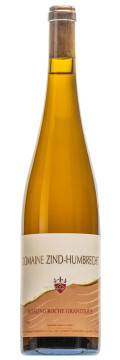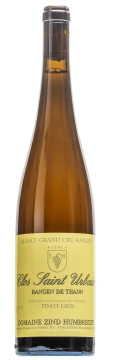Vintage 2023

Description of the vintage
The winter 2022/2023 was relatively dry and mild, but fortunately followed by a cool period in March, pushing back budbreak to early April. This slight delay made it possible to avoid the early April frosts. Temperatures went down to -3°C in some areas and the risk was very present. Early spring was normal with no climatic challenges but with increasingly higher temperatures getting closer to June. Flowering began early June in the precocious vineyards (Clos Jebsal, Turckheim) and ended mid-June in the late terroirs such as Clos Windsbuhl in Hunawihr. June is also characterized by high temperatures at the time of flowering. Of course, this will have helped to avoid disease problems such as mildew, but unfortunately it has caused important coulure on Riesling, a grape variety quite sensitive to excess heat during flowering. The lack of water is showing its effect at the beginning of July on the well-drained gravelly soils of the alluvial valley of the Fecht River in Turckheim. On the hillsides, even on granite, the vines are showing good resistance to drought. In July, it was possible to see that all Riesling vineyards had problems through the flowering and potential crops would be small. However, the Pinot family, especially Pinot-Gris, announces an astonishing fertility: beautiful clusters, unusually large, and well set with no coulure or millerandage at the time of véraison (change of colour) which began mid-July. August is fortunately cooler with the return of some rains, helpful on the hillsides, but not significant enough for the lighter valley floor vineyards. Mid-August, we then estimated to have an early harvest. A few scattered rains at the end of the month, but again not very significant. The soils are very dry just before harvest and it is then possible to note huge differences between the valley floor and hillsides. The berries remained very small with a high ration skin/juice on the valley floor, especially for Riesling, while all the hillsides are showing a nice harvest and a normal evolution. All over Alsace, but mainly around Colmar, the Riesling grape variety would yield an exceptionally small harvest, while the other grape varieties (especially Pinots) promised an abundant harvest.
The dry 2023 summer delayed the technical maturity (sugar) and therefore the start of the harvest was much later than initially planned. In any case, 2023 is marked by a physiological maturity attained well before the maturity in sugar. This is quite rare, but it illustrates the fact that sugar climbs fast in the grapes only if there are enough rainfalls (or irrigation!). Obviously, overcropped vineyards in Alsace will have had difficulty reaching a good level of maturity (especially on Riesling), forcing the winemaker to delay the harvest and expose himself to significant problems of grey and acid rot from mid-September onwards. Pinot-Gris showed big problems in vineyards that had to be harvested later due to the lack of ripeness. On the domaine, the last Pinot-Gris was picked on September 13th from the Grand Cru Rangen. The Pinot Gris that could be harvested before mid-September were in excellent health. Riesling and Gewurztraminer evolved more slowly and remained healthy until the last day of harvest on October 5th with the Riesling Clos Windsbuhl.
The summer of 2023 is mainly marked by drought and a technical maturation later than the physiological maturation. This explains why, with such favourable weather, the 2023 wines are harmonious and show a lower alcohol level than most previous years. Also surprisingly, the 2023 wines fermented vigorously and without any problems, unlike the 2022 vintage where a lot of intervention was necessary in the cellar to restart the fermentations. Acidities are normal and particularly ripe. Some Riesling wines and, as always, the Pinot-Gris from Clos Windsbuhl, finished their fermentation during the summer of 2024. Except for some Gewurztraminer, all the wines acquired a dry balance in the 2023 vintage. No Late Harvest was produced.
The 2023 wines have a beautiful aromatic expression and a ripe mouthfeel without excessive weight. A good phenolic maturity should also guarantee a good aging potential on the great terroirs.































